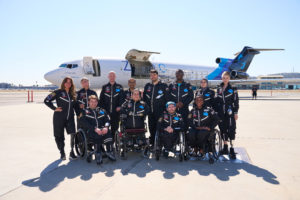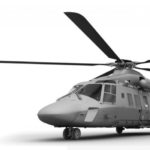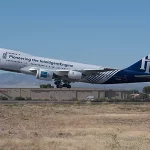AstroAccess, which is dedicated to advancing disability inclusion in space exploration, and Zero Gravity Corporation (ZERO-G) have successfully completed a parabolic flight with a crew of 12 ambassadors with mobility, vision, and hearing disabilities.
The ZERO-G aircraft ascended to an altitude of 32,000 feet, at which point the vehicle commenced its parabolic manoeuvres. Ambassadors carried out planned demonstrations over the course of 15 arcs, experiencing multiple minutes of weightlessness.
During the flight, the crew conducted demonstrations to understand how space vessels can be made more accessible by design and procedure. These tests included new visual and haptic feedback mechanisms to signify phases of flight, crew uniforms intentionally designed for accessibility, interior customisations to provide instantaneous location and orientation awareness for safety in microgravity, and a variety of other additional scientific and technical demonstrations.
Ambassadors: “room for you and need for you” in space
Anna Voelker, Executive Director of SciAccess and Co-Project Lead of AstroAccess, said: “Space removes the barriers between people; now is the time to remove the barriers to space itself. AstroAccess is sending a message to people who have historically been excluded from STEM that not only is there room for you in space, there is a need for you.”
The mission was supported by a wide range of disability and space organisations, including DAV (Disabled American Veterans), Gallaudet University, the Massachusetts Association for the Blind and Visually Impaired, the Space Frontier Foundation, the Lighthouse for the Blind and Visually Impaired and the Whitesides Foundation. The AstroAccess mission was part of SciAccess and under sponsored by Yuri’s Night. In addition to the 12 ambassadors, members of several American companies flying crewed spaceflight vehicles were also onboard the flight.
The mission will not only provide valuable insights on the future of spacecraft design, but also seeks to advance disability inclusion in STEM, inspire the next generation of scientists and inventors, welcome new perspectives into the science community, and demonstrate the benefit of intentional and accessible design in space and here on Earth.
“Important milestone in our mission to open space for all”
George Whitesides, Co-Project Lead of AstroAccess, said: “Yesterday’s successful flight was an important milestone in our mission to open space for all. The tasks and demonstrations carried out by our ambassadors will have a profound effect on the space industry at large, inform the design of future space vehicles, and pave the way for future astronauts with disabilities.”
“One characteristic veterans share is the unwavering desire to serve, and it’s an inclination that continues for many once they no longer wear our nation’s uniform,” said Marc Burgess, CEO and national adjutant of DAV. “We’re incredibly grateful to AstroAccess for giving our ambassador CeCe Mazyck the opportunity to contribute to vital research that will integrate disabled veterans and civilians alike into space and benefit the disabled community and humanity for years to come.”
“Floating in microgravity – truest physical manifestation of pure joy”
Sina Bahram, Flight 1 AstroAccess Ambassador: “Floating in microgravity was the truest physical manifestation of pure joy and delight that I have ever felt in my life. I feel this joy because of the visceral nature of the experience, the progress being made by and for people with disabilities, the more inclusive future we are building, and the recognition that such a future will not exist without us.”
The crew of AstroAccess Ambassadors were:
- Sina Bahram
- Dana Bolles
- Mary Cooper
- Eric Ingram
- Centra Mazyck
- Mona Minkara
- Viktoria Modesta
- Zuby Onwuta
- Sawyer Rosenstein
- Eric Shear
- Apurva Varia
- Sheri Wells-Jensen

